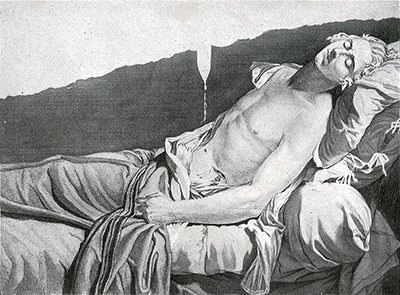Sadly, this portrait was lost, presumed destroyed by the model's daughter who wished to cover up the political role of her father at the time that this painting was made.
Artist David would concentrate on the theme of martyrdom for a number of pieces and was inspired by his own political views which both boosted and hindered his career and life at different points. The scene found in the original painting was copied via the engraving that we have included a photo of here. Michel Lepeletier was assassinated after backing the execution of Louis XVI and his lifeless corpse was painted by the artist in order to underline his sacrifice for a cause that he felt strongly about. David himself would pay for his own beliefs when exiled to Brussels where he spent the final years of his life. Despite that, he was still able to work relatively freely and also meet patrons and models, ensuring his oeuvre could continue to expand right up to his death.
The daughter of Lepeletier, Louise, was the owner of the artwork after David himself passed away. She chose to destroy it, as well as a number of related sketches used for its preparation, in order to try to quiten down knowledge of her father's demise, and the reasons behind it. We do not know if this was down to political disagreements of her own about what he did, or if she was simply trying to take focus away from her own life. Thankfully, some engravings remain which were produced by other artists after the painting had been finished, as a way of learning and studying the technical style of this great painter. Those provide us with at least a good idea of how the original looked, particularly when compared with other paintings from his career that still exist.
It is unfortunate that the original artwork is now longer available, but plenty more still remains from David's career. He can be considered one of the key French artists from between the 17th and 19th centuries, which was a pivotal time in the artistic output of this nation. The Louvre continues to display much of the best work from this period, with the rest dispersed thinly around a number of European and American galleries and museums. Very few are found in private collections today. Those interested in the different movements of this era should also look into the French Romanticists of Delacroix and Gericault, whose style was different to David, but equally skilled technically. Some highlights from their careers include Gericault's Raft of the Medusa and The Wounded Cuirassier, whilst Delacroix created the iconic Liberty Leading the People and also Massacre at Chios.




